The Instant Pot: a modern-day miracle that turns even the most culinary-challenged home cooks into kitchen wizards. Gone are the days of slaving over a hot stove for hours. With just a push of a button, you can whip up everything from creamy risottos to tender roasts faster than you can say “What’s for dinner?” But wait—before diving headfirst into this pressure-cooking paradise, there are a few tips and tricks that can elevate your Instant Pot game from “meh” to “wow!”
Table of Contents
ToggleEssential Instant Pot Tips
For mastering the Instant Pot, users benefit from understanding its functions and avoiding common pitfalls. These tips enhance cooking efficiency and ensure delicious results.
Understanding Your Instant Pot
Familiarity with the Instant Pot’s settings leads to better meals. Many functions, including sauté, pressure cook, and slow cook, offer versatility in meal preparation. Knowing how to use each setting makes a difference in achieving the intended flavors and textures. Pressure levels, either high or low, alter cooking times and outcomes. Understanding the importance of the sealing ring also ensures proper pressure buildup, maximizing efficiency.
Common Mistakes to Avoid
Using too much or too little liquid often results in incorrect pressure. Users should follow guidelines closely, as recipes typically specify required amounts. Overfilling the Instant Pot can cause food to splatter out of the vent, affecting both safety and performance. Not allowing enough natural release time leads to tougher meals. Ignoring the need for preheating can also result in longer cooking times. Remember, staying aware of these common mistakes promotes a smoother cooking experience.
Cooking Techniques for Instant Pot


Understanding key cooking techniques enhances the experience of using an Instant Pot. Familiarity with these methods leads to better results.
Pressure Cooking Basics
Pressure cooking relies on steam to cook food quickly. Users achieve maximum flavor and tenderness by maintaining the right liquid amount, typically one to two cups based on the recipe. Knowing how to set the correct pressure level—high or low—also matters. High pressure cooks faster, while low pressure offers gentler cooking for delicate foods. When time is critical, using the quick release method allows for immediate access to meals. For optimal flavor, the natural release method gradually releases steam, letting flavors meld. Consistency in following these basic steps results in delicious, timely dishes.
Sautéing and Browning
Sautéing and browning infuse dishes with rich flavors. The sauté function on the Instant Pot allows users to prepare ingredients before pressure cooking. It’s crucial to add oil or butter to the inner pot to prevent sticking. Starting with aromatics such as onions or garlic builds a flavor base. Cooking until golden brown enhances the overall taste of the dish. After achieving the desired browning, users can add other ingredients and proceed to pressure cook. Utilizing this method adds depth to meals and maximizes the capabilities of the Instant Pot.
Instant Pot Recipe Tips
Using the right strategies enhances Instant Pot cooking. Various techniques can simplify meal preparation and improve results.
Best Ingredients for Instant Pot Cooking
Choosing high-quality ingredients makes a significant difference. Fresh vegetables like carrots and bell peppers respond well to pressure cooking. Lean meats, including chicken and turkey, retain moisture better than fatty cuts. Whole grains, such as quinoa and brown rice, work effectively if liquid content is adjusted. Broths and stocks add rich flavors to soups and stews. Dry beans require soaking beforehand to ensure even cooking. Simple items like garlic and onions enhance depth in recipes. Always consider ingredient compatibility for a successful outcome.
Modifying Traditional Recipes
Adapting traditional recipes ensures efficiency in the Instant Pot. Reduction in liquid is crucial since pressure cooking creates steam. Cooking times often decrease for many dishes; 30 minutes in the oven may translate to 10 minutes under pressure. Adjust seasoning levels to account for concentrated flavors from pressure cooking. For slow-cooked recipes, select the right pressure cooking method to maintain ingredients’ integrity. Conversions from stovetop to Instant Pot may require experimentation for best texture and flavor. It’s beneficial to prioritize ingredients that flourish under pressure, ensuring flavorful results.
Maintenance and Cleaning Tips
Cleaning the Instant Pot regularly maintains its performance and longevity. Detaching the sealing ring after each use prevents odors from lingering. The inner pot is dishwasher-safe, simplifying your cleanup. Rinsing the lid under warm water helps remove food particles, ensuring optimal function.
Inspecting the steam release valve regularly prevents clogs. Using a toothpick to dislodge any debris keeps the valve functional. Checking the heating element helps avoid issues with cooking.
Descaling the Instant Pot every few months is essential, especially in areas with hard water. Mixing equal parts of vinegar and water and running a short cycle effectively removes mineral buildup. Following this, rinsing the pot thoroughly ensures no vinegar taste remains in future dishes.
Storing the Instant Pot appropriately also contributes to its lifespan. Keeping it in a dry and cool location prevents corrosion. Leaving the lid off during storage allows air circulation, preventing mold growth.
Keeping the exterior clean enhances the appliance’s appearance. Wiping it down with a damp cloth after each use keeps it looking new. For stubborn stains, using a gentle cleaner helps maintain the finish without damage.
Following these maintenance and cleaning tips promotes a better cooking experience. Routine care ensures that an Instant Pot serves its purpose efficiently and remains a reliable kitchen companion. Regular attention to these aspects not only increases device longevity but also enhances food safety.





